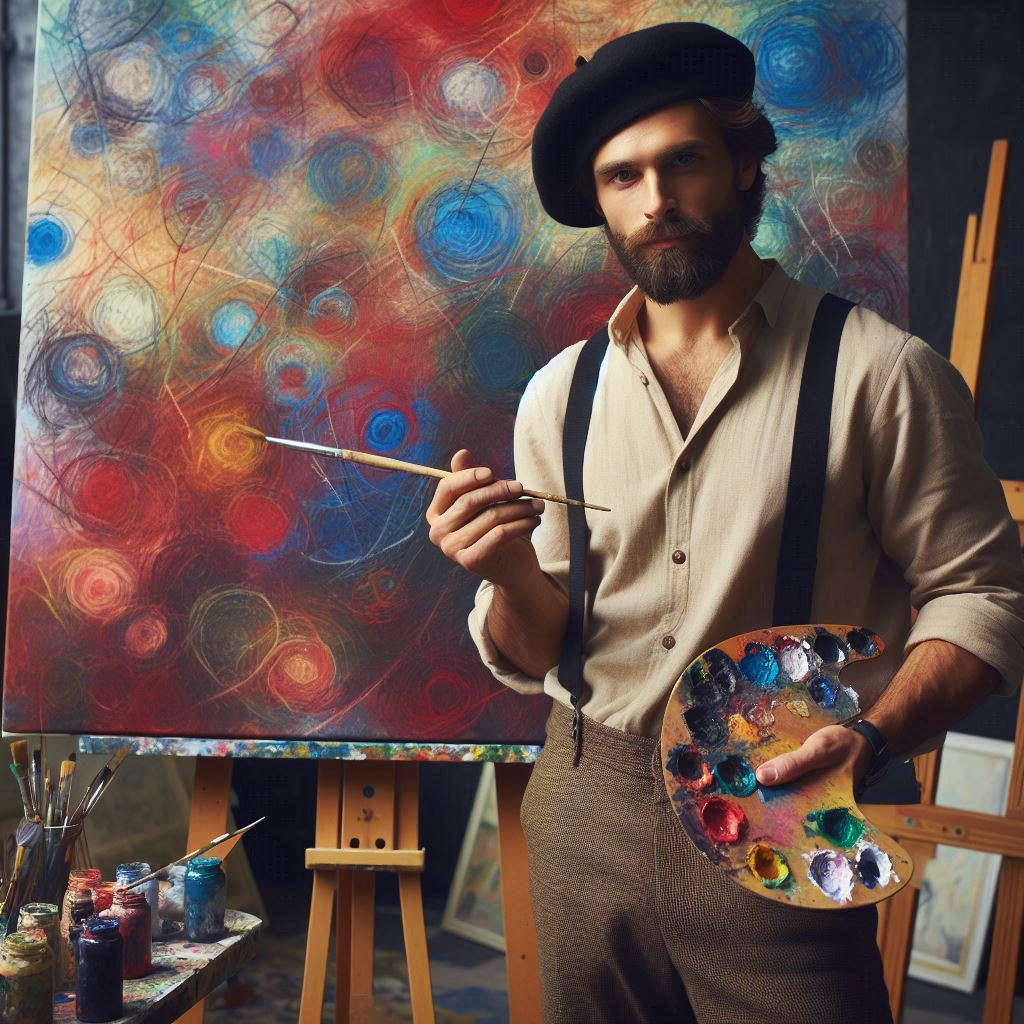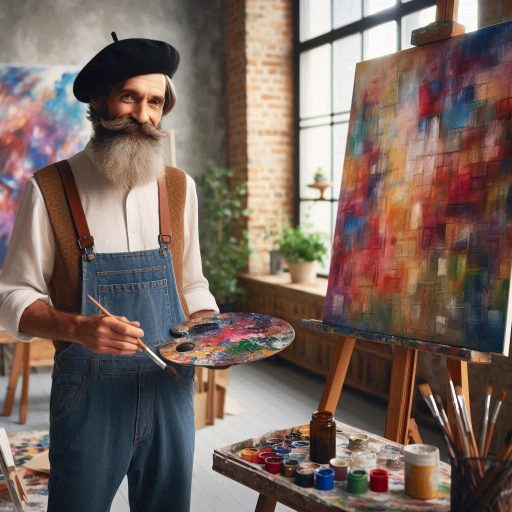Introduction
Art therapy is a therapeutic approach that utilizes creative activities to improve mental, emotional, and psychological well-being.
It combines traditional therapeutic techniques with the expressive power of art, allowing individuals to explore their feelings and experiences through various artistic mediums.
In an art therapy session, participants may engage in activities such as painting, drawing, sculpting, or collage-making.
These creative endeavors serve as a form of self-expression, enabling individuals to communicate thoughts and emotions that may be difficult to articulate verbally.
The importance of creative activities in art therapy sessions cannot be overstated.
Engaging in these activities allows individuals to tap into their imagination and intuition, promoting self-discovery and healing.
Creative expression can be especially beneficial for those dealing with trauma, anxiety, or depression, as it provides a safe outlet for processing complex emotions.
Additionally, the act of creating art fosters mindfulness and presence, helping participants focus on the moment and alleviate stress.
Ultimately, creative activities in art therapy empower individuals to explore their inner worlds, gain insights, and foster personal growth.
Benefits of Creative Activities in Art Therapy
Helps Individuals Express Emotions and Thoughts
Art therapy provides numerous benefits through creative activities.
These activities help individuals express their emotions and thoughts effectively.
Many people struggle to articulate feelings verbally.
Creative mediums, such as painting or drawing, allow for nonverbal communication.
This form of expression often leads to breakthroughs in understanding personal experiences.
Encourages Self-Discovery and Self-Expression
Engaging in art therapy encourages self-discovery and self-expression.
Individuals explore their identities and beliefs through creative projects.
This process can unveil hidden thoughts and feelings.
As clients experiment with colors and forms, they discover new aspects of themselves.
This self-exploration fosters a sense of empowerment.
Understanding one‘s emotions can lead to healthier coping mechanisms.
Promotes Relaxation and Stress Relief
In addition to self-discovery, creative activities promote relaxation and stress relief.
Art therapy sessions provide a safe space to unwind.
Clients often experience a sense of calm while engaged in creative tasks.
Focusing on art can distract from daily stressors.
This immersion in creativity allows individuals to recharge mentally and emotionally.
Studies show that creating art can lower anxiety and depressive symptoms.
The repetitive motions involved in certain activities, like painting or sculpting, can be soothing.
This rhythm can act as a form of meditation, allowing individuals to find peace.
As clients create, they may experience a reduction in tension and worry.
Art therapy also fosters social connections.
Group sessions encourage collaboration and communication among participants.
Sharing creative work can lead to meaningful conversations about feelings and experiences.
This shared experience promotes a sense of belonging, reducing feelings of isolation.
Building connections in this way is crucial for mental well-being.
Additionally, creative activities boost cognitive function.
Engaging in art can improve problem-solving skills and critical thinking.
Individuals learn to make choices about color, form, and technique, which stimulates brain activity.
This cognitive engagement can lead to enhanced focus and concentration over time.
The physical benefits of art therapy cannot be overlooked either.
Many creative activities improve fine motor skills.
Activities like painting, drawing, or sculpting require precise hand-eye coordination.
As individuals practice these skills, they enhance their dexterity and control.
Creative activities in art therapy offer diverse benefits.
They help individuals express emotions and thoughts in meaningful ways.
Clients engage in self-discovery, leading to greater self-awareness and empowerment.
Moreover, these activities promote relaxation and stress relief.
Participants can experience mental clarity and enhanced well-being through creative expression.
Ultimately, art therapy serves as a valuable tool for emotional healing and personal growth.
Read: Freelance Character Design: How to Get Started
Types of Creative Activities Used in Art Therapy Sessions
Art therapy encompasses various creative activities that facilitate emotional expression and personal growth.
These activities allow individuals to explore their feelings and thoughts in unique ways.
Here are some common types of creative activities used in art therapy sessions:
Painting and Drawing
Painting and drawing are fundamental activities in art therapy.
They enable individuals to express emotions visually, often revealing feelings that may be difficult to articulate.
Various mediums, such as watercolor, acrylics, and charcoal, provide diverse avenues for expression.
Clients can explore colors, shapes, and forms to represent their inner experiences.
This medium often acts as a catalyst for conversation and self-reflection during therapy sessions.
Sculpting and Clay Work
Sculpting and clay work offer tactile experiences that enhance emotional exploration.
Working with clay allows individuals to manipulate materials, fostering a sense of control and creativity.
This three-dimensional art form engages both the mind and body.
It also encourages mindfulness, as clients focus on the textures and sensations of the clay.
Sculpting can symbolize transformation and growth, allowing clients to manifest their feelings physically.
Collage Making
Collage making involves assembling various materials, such as magazines, photographs, and fabric, to create visual narratives.
This activity encourages self-expression by allowing individuals to combine different elements that resonate with their experiences.
Collages can reflect personal stories, dreams, or challenges.
The process of selecting and arranging images fosters creativity and decision-making, enhancing self-awareness and insight.
Photography and Digital Art
Photography and digital art provide modern tools for self-expression in art therapy.
Clients can capture images that reflect their emotions or experiences, offering a different perspective on their lives.
Digital art, including graphic design and digital painting, allows for experimentation with colors and forms.
These mediums also promote technology use, catering to clients who may feel more comfortable with digital platforms.
Photography encourages individuals to see beauty in everyday moments, fostering gratitude and mindfulness.
In summary, various creative activities enhance the art therapy experience.
Painting and drawing, sculpting and clay work, collage making, and photography all offer unique benefits.
Each activity provides opportunities for self-exploration, emotional expression, and personal growth.
By engaging in these creative processes, clients can uncover insights and develop healthier coping strategies.
Art therapy ultimately serves as a powerful tool for healing and transformation.
Read: Career Paths: Becoming a Professional Character Designer
Role of the Art Therapist in Guiding Creative Activities
The art therapist plays a crucial role in facilitating creative activities during therapy sessions.
Their guidance is essential for fostering a safe and supportive environment.
Here are some key responsibilities of art therapists in this process:
Providing Prompts and Themes for Art-Making
Art therapists provide prompts and themes to inspire creative expression.
These prompts can range from specific subjects, such as “peace” or “growth,” to abstract concepts, like “feelings of joy.
By offering themes, therapists encourage clients to explore their thoughts and emotions visually.
This direction helps clients who may feel unsure about where to start.
Additionally, prompts can stimulate creativity, making the art-making process more engaging and meaningful.
Supporting Individuals in Exploring Their Creativity
Art therapists support individuals in exploring their creativity without judgment.
They create a safe space where clients feel comfortable taking risks and experimenting with various mediums.
Therapists encourage clients to express themselves freely, emphasizing that there are no right or wrong ways to create art.
This supportive atmosphere helps individuals build confidence in their artistic abilities.
As clients explore different techniques and styles, they often discover new aspects of themselves and their emotions.
Interpreting and Processing Artworks with Clients
Interpreting and processing artworks is a significant aspect of an art therapist’s role.
After creating art, therapists guide clients in discussing their pieces.
This conversation can reveal insights into the client‘s emotions and experiences.
Therapists help clients articulate their thoughts, feelings, and intentions behind their creations.
This reflective process fosters self-awareness and can lead to important breakthroughs in therapy.
By interpreting artworks together, therapists facilitate deeper understanding and connection to the client’s journey.
The art therapist plays an essential role in guiding creative activities.
By providing prompts and themes, they inspire artistic expression.
Their support encourages individuals to explore their creativity freely.
Additionally, interpreting and processing artworks fosters deeper insights into clients’ emotions and experiences.
Through these efforts, art therapists empower clients on their paths to healing and personal growth, enhancing the overall effectiveness of art therapy.
Read: Best Tools and Software for Character Designers

Case Studies
Art therapy has transformed countless lives by facilitating emotional expression and personal growth through creative activities.
Here are some illustrative case studies showcasing how art therapy has positively impacted individuals.
Transform Your Career Today
Unlock a personalized career strategy that drives real results. Get tailored advice and a roadmap designed just for you.
Start NowExamples of How Creative Activities Have Helped Individuals
In one case, a young woman named Sarah struggled with anxiety and depression.
During her art therapy sessions, she engaged in painting to express her emotions.
Initially hesitant, Sarah found comfort in creating abstract art.
Over time, she transformed her chaotic feelings into vibrant colors and shapes on canvas.
This process allowed her to externalize her internal struggles, leading to greater self-awareness.
Sarah’s artwork became a visual representation of her healing journey.
Another example involves a teenage boy named Alex, who faced significant challenges due to bullying.
In therapy, Alex created a collage that depicted his dreams and aspirations.
By cutting out images and words from magazines, he crafted a visual representation of hope and resilience.
This activity helped him shift his focus from negative experiences to positive goals.
Alex’s confidence grew as he shared his collage with the therapist, fostering a sense of accomplishment and empowerment.
Personal Anecdotes or Success Stories
One notable success story involves a middle-aged man named Tom.
After losing his job, Tom experienced feelings of worthlessness.
In art therapy, he began sculpting with clay.
As he shaped the clay, Tom found solace in the tactile experience and discovered a new passion for art.
He crafted various pieces that reflected his emotions, ultimately creating a sculpture that symbolized rebirth.
This transformative experience led Tom to pursue a career in art, reigniting his sense of purpose and self-worth.
Another impactful story comes from a woman named Emily, who had difficulty processing trauma from her childhood.
Through art therapy, she used painting to express her feelings.
Emily created a series of self-portraits that captured her journey from pain to healing.
As she painted, she confronted her past and found a way to reclaim her narrative.
This process allowed her to gain control over her story and ultimately led to significant emotional healing.
Illustrations of Art Therapy Sessions in Action
In a group art therapy session, participants were encouraged to create a collective mural representing their shared experiences.
The therapist provided a theme centered on “community and support.
” As participants collaborated, they painted various symbols of connection, such as hands and hearts.
This activity fostered communication and bonding among group members, allowing them to share their stories while creating a meaningful piece of art together.
In another session, a therapist introduced a creative writing exercise combined with visual art.
Clients were asked to write a short poem about their emotions and then illustrate it.
This dual approach helped individuals articulate their feelings verbally and visually.
Clients shared their work, fostering an atmosphere of vulnerability and support.
This integration of different artistic mediums enriched the therapeutic experience, allowing for deeper exploration of emotions.
These case studies highlight the profound impact of creative activities in art therapy.
Through painting, collage-making, sculpting, and collaborative projects, individuals have found healing and empowerment.
Personal anecdotes demonstrate how art therapy can transform lives by facilitating emotional expression and self-discovery.
By illustrating art therapy sessions in action, we see the power of creativity in fostering connection and growth.
Ultimately, these stories underscore the effectiveness of art therapy as a valuable tool for healing and personal development.
Read: Ceramic Art: From Hobby to Professional Career
Addressing Challenges in Creative Activities
Art therapy is a powerful tool for self-expression and healing, but challenges can arise during creative activities.
Addressing these challenges is crucial for effective therapy.
Here are some common challenges faced in art therapy and strategies for overcoming them.
Overcoming Creative Blocks
Creative blocks are common obstacles in art therapy sessions.
Individuals may struggle to express themselves due to self-doubt or fear of judgment.
To overcome these blocks, art therapists often use specific techniques.
They may provide prompts or themes to spark inspiration.
For example, a therapist might suggest creating art based on a favorite memory or emotion.
Another effective approach is to encourage free expression without expectations.
Clients can create art without worrying about the outcome.
This freedom fosters creativity and reduces pressure, helping individuals reconnect with their artistic instincts.
Simple activities, such as doodling or working with colors, can also help break the block and encourage flow.
Dealing with Resistance to Art-Making
Resistance to art-making can stem from various factors, including anxiety, past experiences, or discomfort with the medium.
Some clients may feel intimidated by their artistic skills or fear making mistakes.
To address this resistance, art therapists create a supportive environment that emphasizes self-acceptance.
Therapists may engage in open discussions about these fears.
By acknowledging feelings of inadequacy, therapists can help clients understand that art therapy is a personal journey, not a competition.
Introducing low-pressure activities, such as using finger paints or exploring different materials, can help ease resistance and promote a sense of playfulness.
Additionally, allowing clients to choose their preferred mediums can empower them and increase engagement.
By providing options, such as drawing, painting, or collage-making, individuals can feel more in control of their creative process.
Adapting Activities for Different Individuals and Their Needs
Every individual in art therapy is unique, with different needs and abilities.
Adapting activities is essential for ensuring everyone can participate fully.
Art therapists assess each client‘s preferences and comfort levels to tailor the activities accordingly.
For clients with physical limitations, therapists can modify materials or provide adaptive tools, such as larger brushes or ergonomic supplies.
This adaptation ensures that everyone can engage in the creative process comfortably.
For group sessions, art therapists often create activities that promote collaboration while respecting individual differences.
Group projects, like collaborative murals, allow participants to contribute their unique perspectives while fostering connection and support.
Additionally, therapists consider the emotional and cognitive needs of clients.
Some individuals may benefit from guided activities, while others may prefer open-ended exploration.
By observing and listening to clients, therapists can adjust their approaches, fostering a more inclusive and effective therapeutic experience.
Addressing challenges in creative activities is essential for successful art therapy.
Overcoming creative blocks requires inspiration and encouragement, while dealing with resistance necessitates a supportive environment.
Adapting activities for different individuals ensures that everyone can participate meaningfully.
By navigating these challenges, art therapists can create a transformative experience, helping clients unlock their creativity and achieve personal growth.
Ultimately, addressing these challenges enhances the effectiveness of art therapy as a powerful tool for healing.
Incorporating Mindfulness and Meditation into Creative Activities
Integrating mindfulness and meditation into creative activities enhances the therapeutic experience in art therapy.
These practices foster self-awareness and emotional regulation, promoting a deeper connection to oneself.
Here are several ways to incorporate mindfulness into creative activities.
Using Art as a Form of Mindfulness Practice
Art can serve as a powerful form of mindfulness practice.
Engaging in creative activities allows individuals to focus on the present moment.
This focus shifts attention away from stress and anxiety, fostering a sense of calm.
For instance, clients can practice mindful drawing by concentrating on the lines and shapes they create.
Art therapists often guide clients in observing their materials, colors, and textures.
This sensory awareness cultivates mindfulness, allowing individuals to immerse themselves fully in the process.
By encouraging clients to notice their thoughts and feelings without judgment, art becomes a vehicle for self-discovery and relaxation.
Connecting Art-Making with Relaxation Techniques
Connecting art-making with relaxation techniques can enhance the therapeutic process.
Before starting a creative activity, therapists may guide clients through deep breathing exercises or progressive muscle relaxation.
These techniques help individuals enter a relaxed state, making them more receptive to the art-making process.
During art sessions, therapists can encourage clients to pause periodically, taking deep breaths as they create.
This practice allows individuals to stay grounded and aware of their emotions.
By incorporating relaxation techniques, clients can use art to release tension and cultivate a sense of peace.
Another approach involves creating art in a calming environment.
Soft music, natural lighting, and comfortable seating can enhance relaxation during sessions.
These elements help clients feel safe and supported, further promoting mindfulness in their creative activities.
Enhancing Self-Awareness and Emotional Regulation
Incorporating mindfulness into art therapy enhances self-awareness and emotional regulation.
As clients engage in creative activities, they often gain insights into their feelings and thoughts.
Mindful art-making encourages individuals to observe their emotions without judgment.
This practice fosters a greater understanding of their emotional landscape.
Art therapists may encourage clients to reflect on their creations after completing a piece.
Discussing the emotions and thoughts that arose during the process can deepen self-awareness.
Clients can explore how specific colors, shapes, or themes relate to their experiences, providing valuable insights into their emotional states.
Furthermore, using art as a tool for emotional regulation can be beneficial.
Clients can create art that reflects their emotions, helping them process difficult feelings.
For instance, someone experiencing anxiety might use swirling colors to depict their internal turmoil.
This visual representation serves as an outlet for expression and can facilitate discussion around coping strategies.
Incorporating mindfulness and meditation into creative activities significantly enhances the art therapy experience.
Using art as a form of mindfulness practice encourages individuals to focus on the present moment.
Connecting art-making with relaxation techniques helps clients feel more at ease during sessions.
Ultimately, these practices enhance self-awareness and emotional regulation, allowing clients to navigate their emotions more effectively.
By integrating mindfulness into art therapy, therapists provide clients with valuable tools for healing and personal growth.
The Future of Creative Activities Therapy
The field of art therapy continues to evolve, embracing emerging trends and innovations.
As the understanding of mental health and therapeutic practices expands, creative activities within art therapy are also adapting.
Here‘s a look at the future of creative activities in art therapy, including emerging trends, technology integration, and the potential for growth.
Emerging Trends and Research in the Field
Research continues to highlight the benefits of art therapy across various populations.
Emerging studies show how creative activities can effectively address issues such as anxiety, depression, trauma, and chronic illness.
This growing body of evidence is leading to an increased acceptance of art therapy within mainstream mental health practices.
New therapeutic modalities, such as eco-art therapy and community-based art therapy, are gaining traction.
Eco-art therapy connects individuals with nature through creative activities, promoting healing through environmental engagement.
Community art therapy focuses on group dynamics and collective creativity, fostering social connections and shared healing experiences.
Additionally, there is an increasing focus on culturally responsive art therapy practices.
Therapists are recognizing the importance of integrating clients‘ cultural backgrounds into the creative process.
This approach enhances the therapeutic relationship and ensures that art-making is meaningful and relevant to individuals’ experiences.
Integration of Technology in Art Therapy Sessions
Technology is playing an increasingly significant role in art therapy.
Digital art tools and platforms allow clients to explore creativity in new ways.
Online art therapy sessions have become more prevalent, especially since the COVID-19 pandemic.
Virtual platforms provide accessibility for clients who may have difficulty attending in-person sessions.
Therapists are using various digital mediums, such as drawing apps, graphic design software, and virtual reality (VR), to enhance the art-making experience.
VR, in particular, offers immersive environments where clients can engage in creative activities while experiencing relaxation and mindfulness.
These technological advancements open new avenues for artistic expression and therapeutic engagement.
Moreover, teletherapy has made art therapy accessible to diverse populations.
Clients from remote areas or those with mobility challenges can participate in virtual sessions.
This accessibility promotes inclusivity, allowing more individuals to benefit from the healing power of art.
Potential for Creative Activities to Evolve and Expand
The future of creative activities in art therapy holds immense potential for evolution and expansion.
As awareness of mental health issues grows, there is a demand for innovative therapeutic approaches.
Art therapy can adapt to meet the needs of diverse populations, including children, adolescents, and elderly individuals.
Integrating multi-disciplinary approaches can also enhance art therapy practices.
Collaborations with music therapy, drama therapy, and dance therapy can create holistic experiences for clients.
This interdisciplinary approach can deepen emotional expression and foster creativity.
Furthermore, as research continues to explore the neurobiological effects of art-making, art therapy may evolve to include more structured interventions.
Therapists may develop evidence-based practices that combine creative activities with psychological theories to enhance therapeutic outcomes.
The future of creative activities in art therapy is bright and full of possibilities.
Emerging trends and research continue to validate the effectiveness of art therapy, leading to increased acceptance in mental health practices.
The integration of technology opens new doors for creative expression, making therapy more accessible to diverse populations.
As the field evolves, art therapy has the potential to expand, adapt, and flourish, enriching the lives of individuals seeking healing and self-discovery through creativity.
Ultimately, the future of art therapy promises innovative approaches that will continue to empower individuals on their journeys toward mental well-being.
Explore Further: Understanding Furniture Design Patents
Conclusion
Creative activities play a vital role in art therapy, serving as a powerful tool for self-expression and emotional exploration.
These activities are not just about creating art; they are about fostering a safe environment where individuals can express their feelings and thoughts without judgment.
Art therapy uses various mediums, such as painting, drawing, sculpture, and collage, to help individuals articulate complex emotions and navigate their inner worlds.
Engaging in artistic endeavors fosters healing by allowing participants to visualize and process feelings that may be difficult to put into words.
Each stroke of paint or line of pencil becomes a means of communication that transcends verbal limitations, offering a unique opportunity for individuals to express their innermost selves.
Art therapy encourages personal growth by promoting mindfulness and self-reflection.
Through various creative expressions, individuals can gain insights into their behaviors, thoughts, and emotions.
This process often leads to increased self-awareness, helping participants understand their experiences more profoundly.
For instance, someone grappling with anxiety might find that their artwork reflects their internal struggles, prompting them to confront these issues head-on.
The act of creating art provides a unique outlet for managing stress and anxiety, as it focuses the mind and brings a sense of calm.
Participants can immerse themselves in the creative process, temporarily stepping away from their daily challenges.
This distraction can lead to therapeutic breakthroughs, allowing individuals to process emotions in a supportive environment.
Showcase Your Business Today
Reach thousands of readers actively exploring professional services. Publish your business profile and grow your audience now.
Publish Now[E-Books for Sale]
The Big Book of 500 High-Paying Jobs in America: Unlock Your Earning Potential
$19.99 • 500 High-Paying Jobs • 330 pages
Explore 500 high-paying jobs in America and learn how to boost your career, earn more, and achieve success!
See All 500 High-Paying Jobs of this E-Book
1001 Professions Without a Degree: High-Paying American Jobs You Can Start Now
$19.99 • 1001 Professions Without a Degree • 174 pages
Discover 1001 high-paying jobs without a degree! Unlock career tips, skills, and success strategies for just $19.99!




